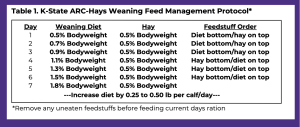One of the primary challenges associated with weaning calves is simply getting newly-weaned calves to consistently consume feed. The transition from a milk and grazed forage to grazed forage and supplement, hay and supplement, or a ration containing novel feeds delivered in a bunk isn’t always easy. However, a little preparation and following a simple feeding management strategy can help calves make this necessary transition. Feeding both cows and calves a small amount of the supplement or weaning ration prior to weaning, in the weaning pen or pasture can be used help acclimate calves to both the feeds and the environment. Additionally, feed intake of weaned calves is often low (1.0 to 1.5 % of bodyweight, dry basis) immediately following weaning. Calves also have relatively high nutrient requirements. Thus, the weaning diet must be nutrient dense to meet the nutrient requirements of the calves at the expected intakes previously mentioned. Unfortunately, the dry feeds calves are often most familiar with (typically grass hays) are not necessarily nutrient dense. At the K-State Agriculture Research Center in Hays, a feeding management protocol for weaning calves has been developed that works well for transitioning weaned calves to a total mixed ration. The protocol is summarized in the table below. Essentially, high-quality grass hay and the weaning ration are offered each at 0.5% of the calves’ current bodyweight, dry basis, on the day of weaning. The weaning ration is placed in the bottom of the bunk and the hay is placed on top. The amount the weaning ration is steadily increased, while the amount of hay offered remains constant. In addition, on day 4 the hay is placed on the bottom of the bunk. Over a period of 7-10 days the dry intake of the calves is steadily increased and should reach approximately 2.2-2.5% of the calves bodyweight by 10-14 days following weaning.
For more information, contact Justin Waggoner at jwaggon@ksu.edu.
